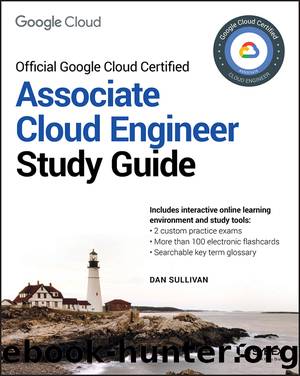Official Google Cloud Certified Associate Cloud Engineer Study Guide by Dan Sullivan;

Author:Dan Sullivan; [Sullivan, Dan]
Language: eng
Format: epub
ISBN: 9781119564393
Publisher: John Wiley & Sons, Inc. (trade)
Published: 2019-03-20T16:00:00+00:00
Nanoseconds, Milliseconds and Microseconds
Some storage systems operate at speeds as unfamiliar to us as what happens under an electron microscope. One second is an extremely long time when talking about the time it takes to access data in-memory or on disk. We measure time to access, or “latency,” with three units of measure.
Nanosecond (ns), which is 10-9 second
Microsecond (μs), which is 10-6 second
Millisecond (ms), which is 10-3 second
Note, the number 10-3 is in scientific notation and means 0.001 second. Similarly, 10-6 is the same as 0.000001, and 10-9 is the same as 0.000000001 second.
Another consideration is persistence. How durable is the data stored in a particular system? Caches offer the lowest latency for accessing data, but this type of volatile data exists only as long as power is supplied to memory. Shut down the server and away goes your data. Disk drives have higher durability rates, but they can fail. Redundancy helps here. By making copies of data and storing them on different servers, in different racks, in different zones, and in different regions, you reduce the risk of losing data due to hardware failures.
Download
This site does not store any files on its server. We only index and link to content provided by other sites. Please contact the content providers to delete copyright contents if any and email us, we'll remove relevant links or contents immediately.
Sass and Compass in Action by Wynn Netherland Nathan Weizenbaum Chris Eppstein Brandon Mathis(7810)
Grails in Action by Glen Smith Peter Ledbrook(7719)
Configuring Windows Server Hybrid Advanced Services Exam Ref AZ-801 by Chris Gill(6843)
Azure Containers Explained by Wesley Haakman & Richard Hooper(6843)
Running Windows Containers on AWS by Marcio Morales(6370)
Kotlin in Action by Dmitry Jemerov(5092)
Microsoft 365 Identity and Services Exam Guide MS-100 by Aaron Guilmette(5071)
Combating Crime on the Dark Web by Nearchos Nearchou(4648)
Microsoft Cybersecurity Architect Exam Ref SC-100 by Dwayne Natwick(4618)
Management Strategies for the Cloud Revolution: How Cloud Computing Is Transforming Business and Why You Can't Afford to Be Left Behind by Charles Babcock(4438)
The Ruby Workshop by Akshat Paul Peter Philips Dániel Szabó and Cheyne Wallace(4336)
The Age of Surveillance Capitalism by Shoshana Zuboff(3980)
Python for Security and Networking - Third Edition by José Manuel Ortega(3895)
The Ultimate Docker Container Book by Schenker Gabriel N.;(3556)
Learn Wireshark by Lisa Bock(3534)
Learn Windows PowerShell in a Month of Lunches by Don Jones(3528)
Mastering Python for Networking and Security by José Manuel Ortega(3376)
Mastering Azure Security by Mustafa Toroman and Tom Janetscheck(3356)
Blockchain Basics by Daniel Drescher(3326)
